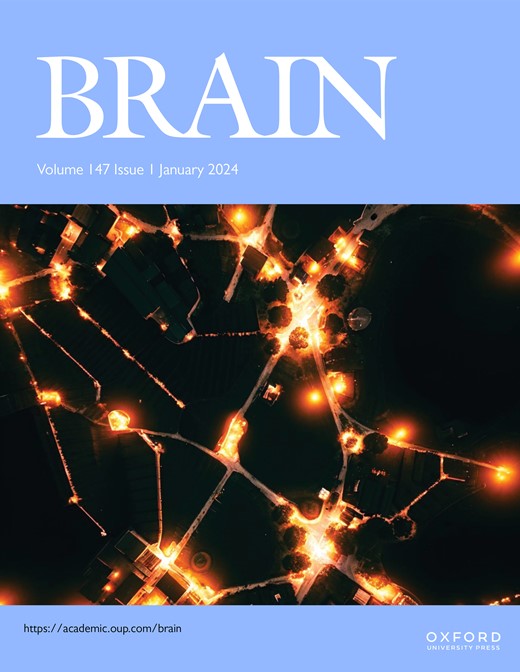癫痫手术后失神的病灶和病灶网络定位
IF 10.6
1区 医学
Q1 CLINICAL NEUROLOGY
引用次数: 0
摘要
颞叶(TL)癫痫手术是治疗耐药性癫痫患者的有效方法。然而,神经外科手术存在认知障碍的风险--多达三分之一的患者在颞叶癫痫手术后会出现命名能力下降。在这项研究中,我们旨在更好地了解与 TL 手术后命名能力下降相关的神经相关因素,目的是为手术规划策略提供信息,以降低命名障碍的风险。我们回顾性地鉴定了85名接受颞叶(TL)切除手术的患者(49名左侧TL患者,36名右侧TL患者),并使用波士顿命名测试(BNT)评估了他们术前和术后3个月的命名能力。我们使用多变量病变-症状映射来确定与命名能力下降相关的切除部位,并使用病变-网络映射来评估与命名能力下降相关的切除部位的广泛功能和结构连接特征。我们在一个由59名左颞叶切除者组成的独立队列中验证了我们的研究结果,并在合并队列后重复了所有分析。病变侧位和位置是手术后命名能力的重要预测因素。右侧颞叶切除术后,命名能力明显提高(P = 0.015),而左侧颞叶切除术后,命名能力下降(P = 0.002)。命名能力的下降与手术切除左侧颞中前回(布罗德曼区 21,r =0.41,P = <.001)以及之前被认为有影响的颞基底语言区有关。与命名能力下降有关的切除部位显示出功能连接特征,其左侧化网络与扩展的语义默认模式网络非常相似,而结构连接特征则是主要的颞额关联白质束穿过颞骨干。这扩展了之前的研究,将左侧颞中前回与命名能力下降联系起来,并为之前确定的颞叶基底语言区在命名能力下降中的作用提供了更多支持。重要的是,这些区域的结构和功能连接特征表明,它们是更广泛的扩展语义网络的关键节点。这些区域和网络研究结果可能有助于手术规划和预后讨论。本文章由计算机程序翻译,如有差异,请以英文原文为准。
Lesion and lesion network localization of dysnomia after epilepsy surgery
Temporal lobe (TL) epilepsy surgery is an effective treatment option for patients with drug-resistant epilepsy. However, neurosurgery poses a risk for cognitive deficits - up to one third of patients have a decline in naming ability following TL surgery. In this study, we aimed to better understand the neural correlates associated with reduced naming performance after TL surgery, with the goal of informing surgical planning strategies to mitigate the risk of dysnomia. We retrospectively identified 85 patients who underwent temporal lobe (TL) resective surgery (49 left TL, 36 right TL) for whom naming ability was assessed before and >3 months post-surgery using the Boston Naming Test (BNT). We used multivariate lesion-symptom mapping to identify resection sites associated with naming decline, and we used lesion-network mapping to evaluate the broader functional and structural connectivity profiles of resection sites associated with naming decline. We validated our findings in an independent cohort of 59 individuals with left temporal lobectomy, along with repeating all analyses after combining the cohorts. Lesion laterality and location were important predictors of post-surgical naming performance. Naming performance significantly improved after right temporal lobectomy (P = 0.015) while a decrement in performance was observed following left temporal lobectomy (P = 0.002). Declines in naming performance were associated with surgical resection of the left anterior middle temporal gyrus (Brodmann area 21, r =0.41, P = <.001), along with a previously implicated basal temporal language area. Resection sites linked to naming decline showed a functional connectivity profile featuring a left-lateralized network closely resembling the extended semantic \ default mode network, and a structural connectivity profile featuring major temporo-frontal association white matter tracts coursing through the temporal stem. This extends prior work by implicating the left anterior middle temporal gyrus in naming decline and provides additional support for the role of the previously identified basal temporal language area in naming decline. Importantly, the structural and functional connectivity profiles of these regions suggest they are key nodes of a broader extended semantic network. Together these regional and network findings may help in surgical planning and discussions of prognosis.
求助全文
通过发布文献求助,成功后即可免费获取论文全文。
去求助
来源期刊

Brain
医学-临床神经学
CiteScore
20.30
自引率
4.10%
发文量
458
审稿时长
3-6 weeks
期刊介绍:
Brain, a journal focused on clinical neurology and translational neuroscience, has been publishing landmark papers since 1878. The journal aims to expand its scope by including studies that shed light on disease mechanisms and conducting innovative clinical trials for brain disorders. With a wide range of topics covered, the Editorial Board represents the international readership and diverse coverage of the journal. Accepted articles are promptly posted online, typically within a few weeks of acceptance. As of 2022, Brain holds an impressive impact factor of 14.5, according to the Journal Citation Reports.
 求助内容:
求助内容: 应助结果提醒方式:
应助结果提醒方式:


